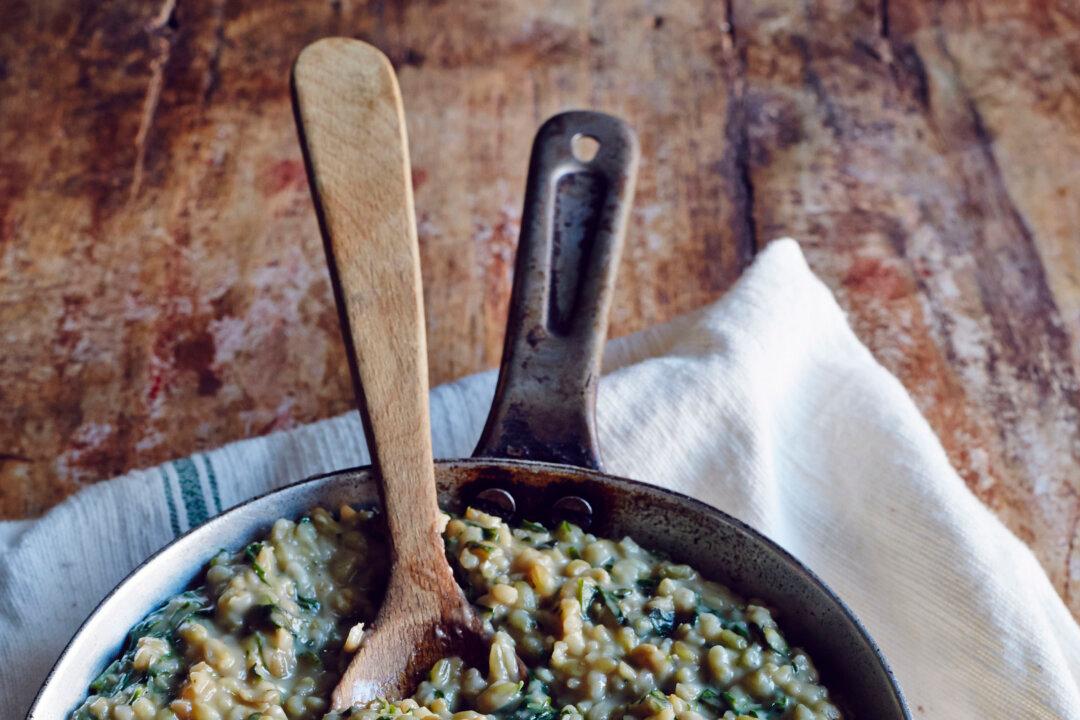Think risotto but with farro. This recipe comes from Sean Brock’s book, “Heritage” (Artisan Books, 2014).
Farrotto with Acorn Squash and Red Russian Kale
Chef Sean Brock (Husk)
Serves 6 as a side dish or 4 as an entrée
Like einkorn, farro is an early form of wheat that can be traced back to the Mediterranean, where it was first domesticated. Actually, the word farro can refer to the hulled grains of einkorn as well as to emmer wheat and spelt. Spelt is the largest variety, what the Italians call farro grande, and it’s what I often source from Anson Mills. I like farro for its nutty flavor and chewy texture. If you have ever made risotto, this recipe will look familiar; it uses the same approach—hence the name. Here I pair farrotto with fall flavors, but it can be a vehicle for whatever looks great at the farmers’ market. Just keep in mind that farrotto brings a bit more heft to the plate than a traditional risotto.
Acorn squash
- 1 small acorn squash (about 2½ pounds)
- 1 tablespoon unsalted butter
- 1½ teaspoons kosher salt
- Scant 1 teaspoon freshly ground white pepper
- 1 cup Vegetable Stock
- 1 bunch Red Russian or other kale (about 3 pounds)
Farrotto
- 2 quarts Vegetable Stock ?1½ teaspoons canola oil
- 1½ cups Anson Mills Farro Verde
- 4 tablespoons unsalted butter
- ½ cup diced white onion
- 1 garlic clove, sliced paper-thin
- ½ cup dry white wine
- 1 cup freshly grated Parmigiano-Reggiano cheese
For the squash:
1 . Preheat the oven to 425°F.
2. Cut the squash in half. Remove and discard the seeds and rinse the squash under cold water. Place the squash cut side up on a rimmed baking sheet. Divide the butter between the two halves and sprinkle with the salt and white pepper. Roast the squash for 35 minutes, or until fork-tender.
While the squash is roasting, prepare the kale:
1. Remove the stems and ribs from the leaves. Make stacks of the leaves, roll them into cylinders, and cut them into very thin ribbons. Wash the kale in a sink of cold water, changing it several times, to remove any sand. Drain and dry with paper towels.
2. When the squash is done, remove it from the oven and pour the butter and juices from the cavities into a container. Let the squash cool enough to handle.
3. Warm the stock in a small saucepan over medium-high heat. Add the butter and juices from the cavities of the squash.
4. Peel the squash. Place the pulp in a blender, add the warm stock and juices, and blend on high to a very smooth puree, about 3 minutes. Set aside.
For the farrotto:
1. Preheat the oven to 425°F.
2. Heat the stock in a partially covered large saucepan over medium heat; keep warm over low heat.
Heat the canola oil in a medium ovenproof skillet over medium heat. When the oil is shimmering, add the farro and stir to coat it with the oil. Place the skillet in the oven and toast the farro for 8 minutes, stirring after 4 minutes. Transfer the farro to a bowl and reserve. Wipe the skillet clean.
3. Put the empty skillet over medium-high heat. When the skillet is hot, about 2 minutes, add 2 tablespoons of the butter and reduce the heat to medium. Add the onion and cook, stirring occasionally, until translucent, about 4 minutes. Add the garlic and cook, stirring constantly, until soft, about 2 minutes. Add the wine, increase the heat to high, and cook until the wine is almost evaporated, about 2 minutes.
4. Add the toasted farro to the pan and stir to coat. Add ½ cup of the warm stock, reduce the heat to medium, and stir until the liquid is almost absorbed. Continue cooking, adding ½ cup of warm stock at a time, stirring to prevent scorching and letting each addition be absorbed before adding the next, until the farro grains have expanded and are al dente, about 1 hour. The farro will look creamy like risotto. (The farro can be made up to 3 days ahead. Cool to room temperature, cover, and refrigerate. Reheat over low heat before proceeding.)
To complete:
Remove the farro from the heat, add the squash puree and kale, and stir until the kale is wilted. Put the skillet back over medium heat and add the remaining 2 tablespoons of butter and the cheese. Stir and serve.
Excerpted from Heritage by Sean Brock (Artisan Books). Copyright © 2014. Photographs by Peter Frank Edwards.






